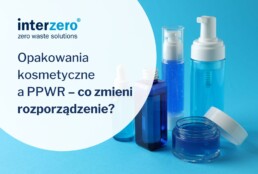
Cosmetics industry facing PPWR - mandatory eco-design of cosmetics packaging
The PPWR Packaging and Packaging Waste Regulation provides for a number of new obligations for cosmetics manufacturers, importers and distributors. They aim to reduce the amount of packaging waste generated and increase the use of recycled materials.
Requirements of the PPWR for cosmetic packaging
Contained in the draft PPWR regulations will affect all businesses introducing packaged products. Cosmetics manufacturers are also included in this group. Let us recall that the current Packaging and Packaging Waste Directive does not introduce any specific requirements for the entire life cycle of cosmetic packaging. However, we are about to experience a real packaging revolution in the cosmetics industry.
With the entry into force of the provisions of the PPWR, the following requirements will apply to the cosmetics industry:
- minimising packaging,
- suitability of packaging for recycling,
- mandatory use of recyclates,
- the need to restrict certain packaging formats (e.g. mini hotel products),
- mandatory labelling of packaging as to sorting and reusability,
- reuse of transport and collection packaging,
- an obligation to reduce the use of biodegradable and compostable packaging.
Minimisation of cosmetic packaging in the spirit of the PPWR regulation
The draft packaging regulation adopted by the EP obliges manufacturers of cosmetic packaging to reduce its weight and volume as much as possible. However, this must be done without compromising the safety of the products packaged in them or the functionality of the packaging itself. This functionality is understood through the following criteria:
- Product protection,
- production and filling processes,
- logistics,
- information requirements,
- hygiene and safety,
- legal requirements,
- recycled content, recyclability and reusability.
From the market multi-layered, double-walled, false bottom packaging will therefore disappear and other elements whose sole purpose is to increase the volume visually.
Minimisation of volume will also have an impact on transport and bulk packaging, in which the the void ratio will be up to 40%.
Suitability of cosmetic packaging for recycling in light of the PPWR regulation
The recyclability of cosmetics packaging will be assessed according to criteria to be implemented in two stages. In phase I, presumably from 1 January 2030, each packaging will have to meet EU design criteria for recycling (Design for Recycling), which take into account the state of the art, collection and sorting. In phase II, implemented from 1 January 2035, packaging will have to meet DfR criteria and an additional criterion demonstrating their 'large-scale' recyclability.
The PPWR regulation will therefore make it necessary to eco-design of all packaging, i.e. designing it for later recycling.
Cosmetics packaging will be categorised into different recyclability classes, the highest of which will be class A, indicating a recyclability of 95% or more by weight of packaging. Packaging whose recyclability will be less than 70% by weight (Class E or below), will not be able to be placed on the market in the EU. The amount of the product fee (eco-modification) will also be linked to the recyclability class.
Recycled cosmetic packaging as a new reality after PPWR
The draft PPWR regulation also provides for Mandatory use of plastics recovered from post-consumer waste (recyclates) for cosmetic packaging. The way in which it will be determined (per unit of packaging, per manufacturer's product portfolio or per other unit) has not yet been definitively confirmed, nor have the levels of use of recyclate proposed to the cosmetics industry. Initially, these were to be 10% of recyclate by 2030 and 55% by 2040. Whether these proposals will be maintained or increased is likely to be known by the end of this year.
In order to meet the projected regulations, leading players in the cosmetics industry are constantly expanding their range of products in recycled or recycled-infused packaging. Such ecological cosmetic packaging They are also often minimised.
Mini-hotel cosmetics under censorship
Not all types of packaging will see a major overhaul - some of them will be completely banned. We are talking about miniature hotel cosmetics. This packaging format has been assessed by the European Commission as excessive or unnecessary.
Once the PPWR comes into force, however, travel mini cosmetics up to 100 ml will remain on drugstore shelves - only hotel products will be banned. However, it is well known that the EC may expand the catalogue of banned packaging in the future.
PPWR-compliant labelling of cosmetic packaging
The PPWR regulation also aims to harmonisation of the labelling on packaging. They will have to clearly indicate the material composition packaging to make it easier for consumers to sort their packaging waste. Reusable packaging, meanwhile, will feature a QR code or other information to facilitate reuse.
With the introduction of the new labelling, information that could confuse or mislead consumers will be prohibited on the labels and throughout the packaging.
PPWR regulation as a stop on the road to sustainable cosmetic packaging
All requirements under the draft PPWR are designed to reduce the consumption of primary raw materials, slow down the rate of growth of packaging production and increase the proportion of recycled materials in almost all packaging, not only cosmetic packaging. The effect of their implementation is to bring the whole EU closer to the goal of a low-carbon, closed-loop economy.
PPWR regulations cover the entire life cycle of packaging, placing particular emphasis on designing for later recycling and closing the raw material cycle. This is due, among other things, to the fact that plastic packaging is highly carbon intensive, and in terms of fossil fuel consumption recycling of the resulting waste is five times more beneficial than incineration with energy recovery[i].
The final text of the PPWR was adopted by the European Parliament on 24 April 2024. As expected, the Council will confirm the adoption of the regulation by the end of this year at the latest, and the new rules will take effect from 2026.
[i] https://data.consilium.europa.eu/doc/document/ST-16946-2023-INIT/pl/pdf